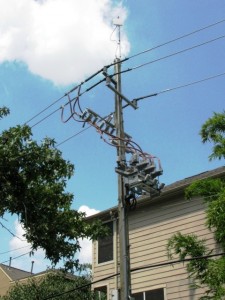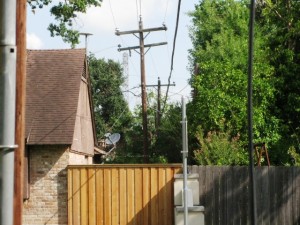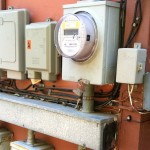Restoring Power: What Houston Learned From Ike

Dave Fehling / StateImpact
Power pole in Houston with antenna and equipment to allow remotely controlled switching
In the five years since Hurricane Ike knocked out power in most of metropolitan Houston, the city now has more high-tech power poles and fewer trees in power line rights-of-way. But there’s no real assurance of a better outcome the next time a big storm hits.
“If you get another direct hit from a large category hurricane such as Ike, you will probably still have the same amount of people impacted,” said David Baker, CenterPoint Energy’s Vice President in charge of 50,000 miles of wires and poles. “But we’ve tried to apply lessons learned from Ike to speed the recovery up and make that go faster.”
Hurricane Ike was a strong Category 2 storm when it made landfall in Galveston, leaving 95 percent of CenterPoint’s 2.26 million customers in the dark. Ten days later, 75 percent of them had power restored. It would take a week longer to get to everyone else.
Dominic Krus was among them. After two and a half weeks, the lights came back on in his home in Houston’s Sharpstown subdivision.
“My wife says the lights are on. I said, ‘Oh great, we can sleep with AC tonight.’ It was a pretty happy event,” said Krus.
Making the Recovery Faster

Dave Fehling / Stateimpact
CenterPoint's David Baker oversees the grid powering 2.26 million customers
When Ike hit, CenterPoint was in the midst of a program to install hundreds of what are called Remote Telemetry Units. They’re electronic boxes and antennas attached to power poles.
The equipment sends and receives data to and from computers at the utility company’s control center. If power is lost, the data help the devices automatically reroute power from unaffected lines, restoring power almost instantly without a technician having to do it by driving to the neighborhood and throwing the switch manually.
In a major hurricane, there may not be any power to re-route. But in less serious wind storms and other more common events, the remotely controlled devices have already made a difference.
“We benefit from that daily if a tree falls on a line or a car hits a pole,” said Baker.
By next year, CenterPoint hopes to have 25 percent of the Houston power grid equipped with the devices, with total coverage taking years longer. The project will cost $200-$400 million, part of which already has been covered by a $50 million federal stimulus grant.
Winds Don’t Kill Power, Trees Do
After Ike, a task force appointed by the Houston mayor tried to pinpoint what caused the massive power outage. Surprisingly, it found that only 1 percent of the city’s one million wooden poles were damaged. All the big, high voltage towers and the substations survived unharmed.
So what was the culprit? The report blamed trees and limbs that were blown onto power lines, shorting or knocking them out.

Dave Fehling / StateImpact
Power outages from Hurricane Ike were blamed on trees hitting power lines
Since Ike, CenterPoint has gone into lumberjack mode, cutting down 37,000 trees in rights-of-way last year alone, and thousands more this year. The tree-trimming took on even more importance after drought in 2011 killed or weakened millions of trees, making them all the more easy for winds to topple onto power lines.
The Texas Public Utility Commission last year approved a new rule requiring that utility companies report the status of their vegetation management, but stopped short of mandating how trees should be trimmed.
Undergrounding
As happens after most big storms, people wonder why electrical lines aren’t just buried (a national review of “undergrounding” of power lines can be found in this 2012 report by the Edison Electric Institute) . In fact, CenterPoint says, the Houston grid already has an almost equal mileage of power lines buried below ground as are strung above ground. Since 1990, 90 percent of lines in new residential developments have been buried, according to the mayor’s task force report.
But to bury the existing overhead lines would cost an estimated $40 billion, which CenterPoint says far exceeds the total value of the entire grid and isn’t realistic. What’s more, CenterPoint says, with so much of Houston prone to flooding, undergrounding could actually cause outages during heavy rain storms.
